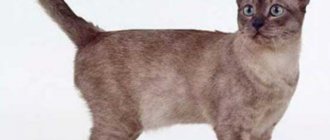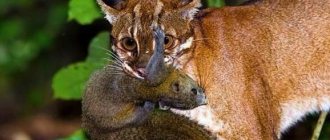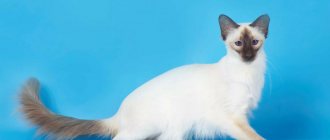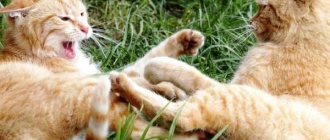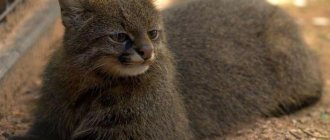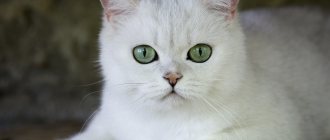This representative is an extremely rare animal inhabiting our planet. This type of cat was first discovered only at the end of the 19th century. The discovery was made by the Dutch scientist-researcher Conrad Jacob Temminck, thanks to whom the cat received the name “Temminck”.
At the moment, the population of this species is extremely rare; only a small number of cats can be found in some zoos. The Temminka Cat itself has a number of other names - Asian Golden, Fiery and Fire Cat.
Description
The Temminck cat has a moderate size, the body length including the head is from 116 to 161 cm. The height at the withers is about 56 cm. Their tail is 1/2-1/3 of the total size. Typically, adults weigh 12-15 kg, which is about two or three times the weight of a domestic cat. Coat colors include the following colors: golden brown, brown, black, red, red and grey. Their coat is of moderate length. The underbelly, the inside of the legs and the lower part of the tail are white. The cat has a well-developed muscular system. Long paws combined with a long tail allow the Temminck cat to climb trees well, although, as a rule, this species lives on the ground. Females are smaller than males.
Appearance
- Life expectancy: no more than 20 years (in captivity).
- Color: the main body shade is dark brown, brown, but there are also subspecies of gray or black colors. At the bottom and at the tip of the tail there are areas of predominantly white tones, and there are characteristic white stripes near the eyes. Some subspecies have distinctive spots on their fur.
- Coat: dense, long, fits well to the body.
- Height at withers: 70-105 cm (depending on habitat).
- Weight: from 12 to 16 kg.
- Litter: 1-3 kittens.
- Recognized by: IUCN.
Did you know? The Asian wild cat is still widely used in Eastern folk medicine, as the tissues of this animal are believed to be endowed with healing substances. In addition, the meat of this mammal species is one of the most expensive delicacies in the world.
- The appearance of this animal is typical for all representatives of large cat breeds, so this cat is often even confused with a puma, since it is very similar to this animal, but differs in its smaller size. Her body is powerful, muscular and flexible, which gives the cat a huge advantage in speed and agility relative to prey.
- Head : small in size, round in shape, elongated muzzle.
- Ears : Set high above the head, tips rounded.
- Eyes : predominantly yellowish or yellow-brown, pupils vertical.
- Legs : paws are high, the front ones are shorter than the hind ones, the claws on the paws are retractable.
- Tail : large, its length reaches 40-55 cm.
Area
Temminck cats are found in the Eastern region and parts of the Palaearctic, southwest Asia, ranging from China and India, through the Malay Peninsula, Thailand and Vietnam. Although the presence of vegetation and adaptation to different environments should make this species thriving, their range is decreasing with increased human activity and high levels of poaching. Currently, these cats can be found in the Phu khieo Wildlife Sanctuary and the Jerangau Forest Reserve.
Habitat
The living space of this animal, in contrast, covers the equatorial part of Central and Western Africa. Habitat: tropical rainforests, mangroves and bamboo thickets, wetlands, coastal thickets. It is found at altitudes up to 3.5 thousand meters; in search of prey it can wander into dry forests and clearings.
The population size does not exceed 10 thousand individuals. Animal migration is limited by natural barriers. Most of the predators live in the Congo River basin. Deforestation and degeneration of rain forests, a decrease in food supply, and poaching cause irreparable damage to the species. The animal is listed in the Red Book.
Habitat
Asian golden cats primarily live in forests, ranging from tropical/subtropical evergreen forests, mixed forests, and dry deciduous forests. They live at altitudes from 1100 to 3738 m (average altitude 2517 m). Phu khieo Wildlife Sanctuary, in Thailand, is considered an ideal habitat for this species. It consists of an enclosed forest, a meadow and an abandoned garden. Using a radio collar, in the Phu khieo nature reserve, Temminck cats were recorded at an altitude of 3738 m (the highest altitude where this species was found). Although habitats are variable within the reserve, Asian golden cats do not show a preference for any particular habitat.
Origin of the species and description
Photo: Temminka the Cat
Temminck's cat is very similar to the African golden cat, but they are unlikely to be closely related because the forests of Africa and Asia were not connected until more than 20 million years ago. Their similarities are most likely an example of convergent evolution.
The Temminck cat is similar to the Borneo Bay cat in appearance and behavior. Genetic studies have shown that the two species are closely related. The Temminck's cat is found in Sumatra and Malaysia, which was separated from Borneo only about 10,000-15,000 years ago. These observations led to the belief that the Borneo Bay cat is an island subspecies of the Temminck cat.
Video: Temminka's Cat
Genetic analysis has shown that the Temminck's cat, along with the Borneo Bay cat and the marbled cat, diverged from other felids about 9.4 million years ago, and that the Temminck's cat and the Borneo Bay cat diverged as much as four million years ago, suggesting that what the latter was a different species long before Borneo's isolation.
Because of its apparent close relationship with the marbled cat, in some regions of Thailand it is called Seua fai ("fire tiger"). According to regional legend, burning the fur of Temminck's cat drives away tigers. Eating meat is believed to have the same effect. Karens believe that it is enough to carry only one cat's fur with you. Many indigenous people consider the cat to be ferocious, but in captivity it is known to be docile and calm.
In China, Temminck's cat is considered a kind of leopard and is known as the "stone cat" or "yellow leopard". The different color phases have different names: cats with black fur are called "ink leopards", while cats with spotted fur are called "sesame leopards".
Interesting fact: The cat was named after the Dutch zoologist Coenraad Jacob Temminck, who first described the African golden cat in 1827.
Reproduction
The breeding of Temminck cats remains relatively unknown, as they are difficult to spot in the wild. Wild individuals tend to be afraid of people and the process of mating of animals has not been observed. The Cincinnati, Heidelberg, Münster and Wassenaar zoos attempted to breed Asian golden cats, with a success rate of 78%. Zoos have carefully designed programs to successfully reproduce animals in captivity. Males become acquainted with females within 2 months, which allows the females to get to know the male well and avoid death.
Many zoos have experienced cat deaths during the breeding season. Males are kept in a separate area and may have visual, olfactory and auditory contact with females. In order to reduce aggressiveness, more food is added to each cell. After two months, the male and female are allowed for short periods of contact with each other. If no aggressive behavior occurs between them, the contact time gradually increases. Females and males stay together for 70 days, during which time they copulate. If the female has not given birth after 90 days, the male gets close to her again during estrus.
Estrus in females lasts 6 days, and the cycle repeats every 39 days. Pregnancy lasts 81 days. Females give birth to 1-3 young, which weigh on average 250 g at birth. In the wild, some females have been observed giving birth in hollow trees. The cubs are weaned at 6 months of age and reach independence at around 12 months, although this sometimes occurs as early as 9 months. Sexual maturity in females occurs at 19 months, and in males at 24 months. Temminck cats are difficult to spot in the wild. Zoos are trying to breed these animals in hopes of gaining more information regarding their behavior and reproduction.
Social structure and reproduction
Photo: Temminka cat kitten
Not much is known about the reproductive behavior of this rather elusive cat in the wild. Most of what is known has been extracted from cats in captivity. Female Temminck cats are sexually mature between 18 and 24 months, and males are sexually mature at 24 months. Females enter estrus every 39 days, after which they leave markings and seek contact with the male by adopting receptive postures. During sexual intercourse, the male will grab the female's neck with his teeth.
After a gestation period of 78 to 80 days, the female gives birth to a litter of one to three kittens in a protected location. Kittens weigh between 220 and 250 g at birth, but triple that during the first eight weeks of life. They are born with the adult fur pattern and open their eyes after six to twelve days. In captivity they live up to twenty years.
Temminck's cat at the Washington Park Zoo (now the Oregon Zoo) showed a sharp increase in the frequency of odor production during estrus. At the same time, she often rubbed her neck and head with inanimate objects. She also repeatedly approached the caged male, rubbed him, and assumed a receptive posture (lordosis) in front of him. During this time, the male's scent speed increased, as did the frequency of his approaching and following the female. The male's superficial behavior included biting the back of the head, but unlike other small felids, the bite was not sustained.
A couple at the Washington Park Zoo produced 10 litters, each consisting of one kitten; two litters of the same kitten, each born at Wassenaar Zoo in the Netherlands, one kitten was registered from the other litter. Two litters of two kittens were born at a private cat breeding facility in California, but neither survived.
Nutrition
Temminck cats adapt to different foods. They consume ground squirrels, mounts, rodents, birds, reptiles and young hares. In the mountains of Sikkim, India, these cats hunt large animals such as wild pigs, Indian sambars and baby Asian buffalos. In areas where humans are present, they also prey on poultry, sheep and goats.
In captivity, the diet of Asian golden cats is not as varied as in the wild. They are fed meat that contains less than 10% fat because fattier foods can cause these cats to vomit. Calcium carbonate and multivitamins are also added to the food. The "dead, whole foods" provided to Temminck's cats include chickens, rabbits, guinea pigs, rats and mice. In zoos, they receive 800-1500 g of food per day.
How much does an exotic animal cost?
Many readers are wondering how much a Temminka cat might actually cost. This is a rather rare and expensive animal, which today is quite a difficult task to buy even for large zoos. But sometimes kittens go on sale from large nurseries that breed rare species, and the price for one kitten starts from several thousand dollars and more.
READ A cat drags kittens from place to place. Why does a cat carry kittens in her teeth?
Important! The Temminka cat is not suitable for keeping at home; in an artificial environment, this animal can only exist in a zoo.
Temminck's cat is a rare animal that is on the verge of extinction, as there are no more than 10 thousand individuals left in the world. This is a colorful and unique species that lives a hidden existence deep in the tropical vegetation of remote areas of Southeast Asia. Therefore, in order to prevent the population of these cats from declining, it is necessary to carefully protect areas of wild tropical forests from complete destruction.
Behavior
Asian golden cats are territorial and solitary animals. Previous observations have shown that they are nocturnal, but a radio-collared field study on two individuals determined that peak activity occurs during the crepuscular and daytime hours. According to the study results, the average territory area of a male was 47.7 km², and that of a female was 32.6 km². Both sexes walked between 55 meters and 9 kilometers per day and were more active in July than in March.
Temminck cats can climb trees when necessary. They are capable of killing prey much larger than themselves. In captivity, Asian golden cats kill small prey by biting their necks, as is typical for felids.
Economic significance for humans
Positive
The meat of Temminck cats is considered a delicacy, and their bones are used for medicinal purposes. Their skin is sold, although this is considered illegal. According to local superstitions, setting fire to the skin of cats drives away tigers.
Negative
Asian golden cats are known to prey on domestic animals such as birds, sheep and goats.
Natural enemies of Temminck cats
Photo: Dangerous cat Temminka
There is a general lack of information about Temminck cat populations and their status, as well as a low level of public awareness. However, the main threat to the Temminck's cat appears to be habitat loss and modification due to deforestation in tropical and subtropical forests. Southeast Asia's forests are experiencing the world's highest rates of regional deforestation, thanks to the expansion of oil palm, coffee, acacia and rubber plantations.
The Temminck cat is also threatened by hunting for its skin and bones, which are used in traditional medicine, as well as its meat, which is considered a delicacy in some areas. In some regions, people believe that consuming Temminck cat meat increases strength and energy. Poaching of the species is believed to be increasing in many areas.
The cat fur trade has been observed along the Myanmar-Thailand border and in Sumatra, as well as in areas in northeastern India. In southern China, Temminck cats have become increasingly sought after for this purpose as significant declines in tiger and leopard populations have shifted emphasis to smaller felid species. Locals follow Temminck's cats and set traps or use hunting dogs to find and corner them.
The species is also threatened by indiscriminate fishing and declining prey numbers due to high hunting pressure. Locals follow the tracks of golden cats and set traps or use hunting dogs to find and corner the Asian golden cat. The species is also threatened by indiscriminate fishing and declining prey numbers due to high hunting pressure. Locals follow the tracks of golden cats and set traps or use hunting dogs to find and corner the Asian golden cat.
The Asian golden cat is also killed in retaliation for the destruction of livestock. A study conducted in villages around Bukit Barisan Selatan National Park in Sumatra found that the Temmincka cat sometimes preyed on poultry and was often persecuted as a result.
